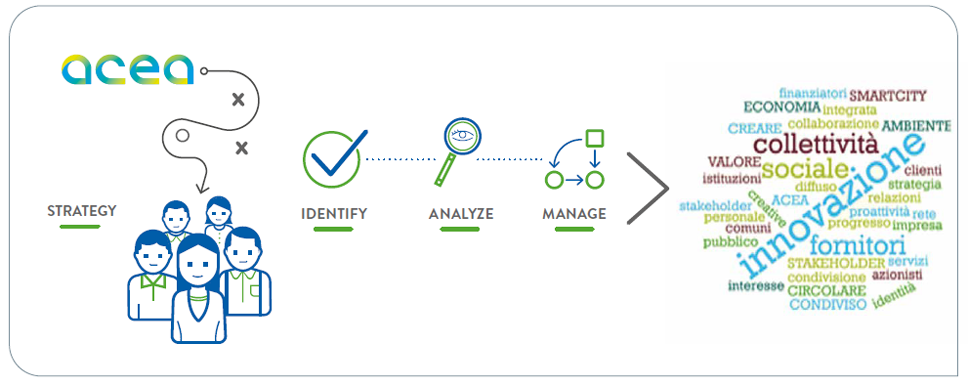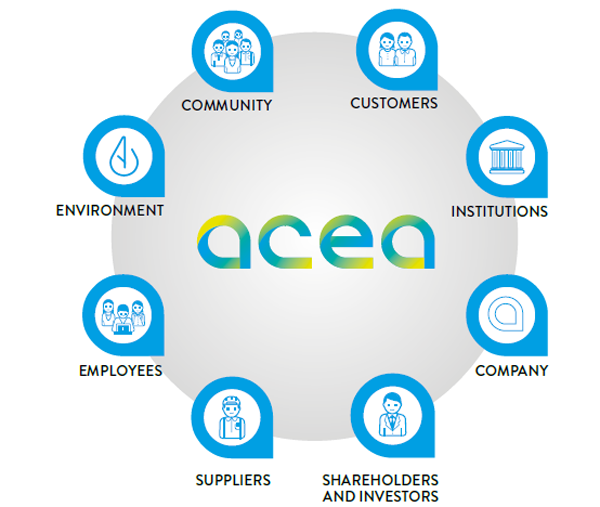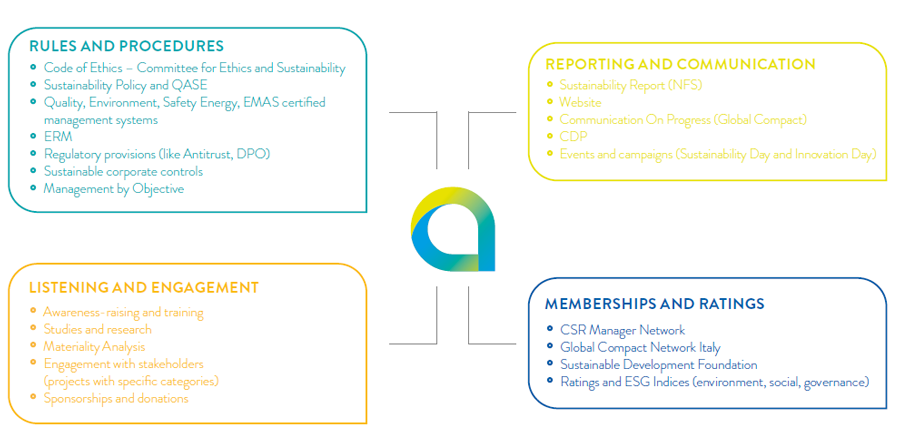Acea promotes the involvement of stakeholders23 in line with the commitments expressed in the Sustainability Policy and the Quality, Environment, Safety and Energy System and the principles set out in the Code of Ethics, with a constructive approach that tends to rely on the results of dialogue and discussion.
Identifying, analysing and managing interactions between the stakeholders and the Company are continuous and dynamic activities stemming from both company actions and objectives as well as inputs from outside.
The stakeholder identification phase makes it possible to identify the parties directly or indirectly involved in company activities in order to assess their level of qualitative and quantitative impact. The analysis phase is used to perform a structured evaluation of the existing interactions both between the company and the stakeholders as well as among the stakeholders themselves so that dialogue and shared accountability paths may be developed.
Lastly, the management phase leads to the identification of answers to the questions raised by the stakeholders or the company in order to pursue the achievement of company goals consistent with expectations.
CHART NO. 15 – STAKEHOLDERS AND THEIR INVOLVEMENT

ACEA GROUP STAKEHOLDER ENGAGEMENT PROJECT
In July 2019, the Acea Group Stakeholder Engagement Project was launched, managed by the Stakeholder Relations Unit (External Relations and Communications Department), to incorporate structured stakeholder engagement within business processes and activities, contribute to the achievement of the objectives set out in the 2019-2022 Sustainability Plan and spread the culture of a strategic approach towards stakeholders in light of the evolution of the context of reference and the Group’s development prospects.
Expected to last 15 months, the Project is based on the following guidelines: developing existing practices in this area; promoting a bottom-up and top-down approach with the involvement of Group companies; creating an integrated system and developing internal skills. All activities are carried out with the direct involvement of the Acea Group Companies/Industrial Segments/ Functions/Departments in a specific phase through an inter-functional and inter-company Working Group.
During the year, the business plan provided for an assessment of the status quo through 24 one-to-one interviews with the top figures of all the Group’s Functions/Departments/Industrial Segments and Companies and 14 interviews with their operating references to gather more detailed information on projects and business initiatives that have been implemented.
16 categories of stakeholders were identified and mapped and in turn divided into 105 subcategories, and the first guidelines of the Group policy document on Stakeholder engagement were drawn up. A first active training session on stakeholder engagement was also carried out within the Working Group.
Two pilot projects of the initiative will be carried out in collaboration with Gori and the Environment industrial segment.
THE RESULTS OF THE FIRST PHASE OF STAKEHOLDER MAPPING

CHART NO. 16 – STAKEHOLDER MAP

For stakeholders, engagement initiatives are organized with the aim of establishing collaborations in a perspective of shared value, to pursue advantages that benefit both the company – consolidating its legitimacy to operate and the pursuit of strategic objectives – and stakeholders, promoting responses to their expectations. The boxes below illustrate the year’s most significant interactions with the main categories of stakeholders.
CUSTOMERS
Acea is one of the main Italian multi-utilities by territory and customers served. Its customer base includes approximately 1.2 million in the energy sector and more than 190,000 gas customers, more than 1.6 million withdrawal points for energy distribution, 2.6 million water users, equal to 8.6 million inhabitants served – for all water companies operating in Italy. Acea is committed to monitoring their satisfaction and to meeting their constantly developing needs. Customers are becoming increasingly engaged, aware and digitized. There is a constant increase in the number of prosumers – both customers and energy producers – in the Areti distribution network (13,591 customers, +9% compared to 2018) and the use of digital tools (180,000 MyAcea app installations, +63% compared to 2018). Water and energy are fundamental elements for the dignity and quality of life, to be used and delivered in the most correct and sustainable forms. One of the initiatives for these purposes is the social water and electricity bonus, regulated by the public system (ARERA) for customers in difficult conditions. In this regard, Acea promotes the awareness of its users through information campaigns.
The company is proactively committed to adopting initiatives that maintain the highest level of trust and good customer relations. In addition to the activities of the ADR Body for the out-of-court settlement of disputes, worthy of note are initiatives aimed at promoting the elimination of abuse in the water sector and important results in preventing cases of unfair commercial practices (60 cases reported to sales agencies during the year, compared with 539 cases in 2018) or anti-competitive conduct (the fine imposed by the AGCM for abuse of a dominant position was fully voided by the Lazio Regional Administrative Court). Finally, taking into account the requests of an increasingly sensitive customer base, Acea has promoted a style of sustainable consumption: in 2019 the total amount of green energy sold was 1,144 GWh, an increase of about 28.5% compared to 2018 (890 GWh).
INSTITUTIONS
For a company that delivers essential public services, mostly subject to regulation by the public authorities, the relationship with institutions is essential both for planning and perfporming the company activities. Moreover, Acea is a strategic player in the multi-level group of public and private entities that contribute to protect higher public interest needs. For this reason it participates in working groups of high institutional profile, in particular on prevention and management of critical events, and guarantees support in case of emergencies to the relevant Authorities in the field of public health, civil protection and public safety.
Among the most relevant issues is the threat to the IT networks of services of general interest. In this area, Acea collaborates with the Computer Emergency Response Team (CERT) of the Ministry of Economic Development, the Network and Information Security Authorities (NIS) of the Ministry of the Environment and the National Anti-Crime Information Centre for the Protection of Critical Infrastructure (CNAIPIC) of the Ministry of the Interior. Finally, in 2019 an important example of the Company’s participation in initiatives of institutional interest was joining the Italian platform coordinated by ENEA and called ICESP (Italian Circular Economy Stakeholder Platform) to promote a national approach to circular economy.
COMPANY
The Business Plan, updated during the year, consolidates the important results already achieved and, confirming the current strategic pillars, sets new and challenging objectives for the Group. Investments as at 2022 reach the figure of 4 billion – the largest commitment ever made by Acea, with an increase of a further 900 million compared to the previous version of the Plan – of which 1.7 billion in projects directly related to sustainability objectives. At the same time, consistent with the industrial lines, the material issues and the sustainability objectives of Agenda 2030, thanks to widespread participation and sharing within Acea the Sustainability Plan was also updated, both at the governance level (guidelines for the Holding Functions) and at the operating level (target of operating companies/Holding Functions). The Group developed in all business segments: in the water segment, strengthening its leadership through the consolidation of companies within the Group and the start of the project to make the Peschiera and Marcio system safe, in the energy segment with the development of photovoltaic production and the resilience of the electricity grid, in the environmental segment with development initiatives on waste recovery and treatment plants.
Acea pays the utmost attention to maintaining an internal organizational infrastructure (procedures, rules, and organizational structures) adequate to the challenges and ready to seize the opportunities emerging from the market. For example, a constant analysis and implementation of the best organizational solutions, like the expansion of Risk & Compliance controls within the Operating Companies or the establishment in the Water Companies of Units responsible for water resource protection initiatives. An enabling driver of the ongoing changes is innovation, as applied to business processes. During the year, Acea Innovation was established to develop projects for the Group and create an ecosystem conducive to innovation and an entrepreneurship culture, and a Memorandum of Understanding was signed with Google Cloud to accelerate the implementation of digital innovation. Finally, particularly worthy of note is the signing of a Network Contract for the establishment of the first Italian Research and Industrial Development Centre engaged in the development of the circular economy and environmental sustainability together with 13 other companies and research centres.
SHAREHOLDERS AND INVESTORS
The relationship with the capital markets guarantees the best conditions thanks to a careful diversification of sources. About 78% of the debt stems from bond placement operations. With regard to bank loans, which are worth about 17%, Acea mainly borrows from institutional operators (EIB, Cassa Depositi e Prestiti) whose mission is to support strategic infrastructure. Relationships with analysts, credit rating agencies and investors are frequently monitored in important national and foreign markets like Milan, London, Paris and New York. During the year, meetings and roadshows were organized with around 130 investors and analysts, for the presentation of annual and interim results and the 2019-2022 Business Plan.
There was a growing presence of ESG investors (environmental, social, governance), representing 4% of the share capital and 26% of institutional investors. Because of this, Acea’s interactions with ESG analysts are in continuous development. During the year, Acea confirmed its presence in the Ethibel excellence investment register, improved its score (A-) in the Carbon Disclosure Project thus being included in the Leadership category and maintained its rating (C+) with ISS ESG. Acea received the first sustainability solicited rating from the Standard Ethics agency, an EE- (investment grade) with a positive long-term outlook.
Finally, Acea was evaluated in its performance by leading sustainability analysts like Sustainalytics, VigeoEiris, Gaia Rating andFTSE Russel ESG.
SUPPLIERS
In 2019, the value of contracts for goods, services and works procured was about € 1.2 billion, with about 1,400 suppliers, up 27% compared to last year’s supplier portfolio. 81% of total volumes were procured through the use of competitive tendering procedures. This year Acea launched a system for monitoring supplier payment times. The protection of suppliers’ personnel was the subject of specific actions between Acea and its social partners. It renewed its commitment to promoting the fight against forms of work that are illegal or inconsistent with applicable national collective bargaining agreements. And for tenders relating to water contracts and the contact centre service (water and electricity) rules relating to the so-called “social clause” were defined and implemented.
For all tenders relating to works, as well as for numerous contracts for goods and services, suppliers must have an ISO 9001 certified management system and sustainability criteria have been defined for 11 product categories of goods and services (out of 30 compatible categories) to be applied in the tender. Similarly, MEC references (minimum environmental criteria) have been applied in 9 out of 10 cases, according to the product categories being procured. Acea assesses its suppliers’ ESG approaches, starting from registration with Qualification Systems. This year more than 87% of qualified suppliers completed the self-assessment questionnaire on quality, environment, safety, energy and social responsibility management systems. Worker safety, which is a fundamental element for the services provided to the Group, was verified through 12,481 on-site inspections (+11% compared to 2018).
EMPLOYEES
Employees are the company’s most important asset. Acea is committed to creating the best conditions of stability, promoting safety and developing a sense of cohesion and participation in the company’s mission. The percentage of resources with a permanent contract (98%) and the average duration of the employment relationship (64% of the people who left the Group during the year served for between 30 and 50 years) testify to a structured and long-lasting relationship with the company. The presence of women is 22% of the total workforce. Considering the governing bodies (Board of Directors, Board of Statutory Auditors and 231 Supervisory Bodies), the percentage of women in the companies within the scope, excluding the Holding Company, with 55.6%, is 33.5%.
The favourable climate of industrial relations is the foundation for the trade union agreement from which the Group Welfare Plan was born, which made numerous services available to participants, based on the needs carefully identified in the company’s population and used by over 2,700 people. Acea sought to further boost employees’ participation in the Plan by redeploying part of the tax relief enjoyed, both by making additional payments and by offering healthcare services and preventive check-ups.
With regard to the protection of employee safety, Acea has developed tools aimed at improving the operating management of occupational safety, including the HSE dashboard (Health, Safety, Environmental) to monitor the performance data underlying the improvement measures, and the new Group Safety Guidelines drawn up also taking into account the findings of the meetings with the Group’s Prevention and Protection Managers. In 2019 the Acea SiCura di te campaign for the prevention of accidents took place, which involved 31 managers, 206 safety specialists and 84 Ambassadors and included 174 cascading sessions. Finally, the relationship of responsibility and mutual trust between the company and its workers and the participation of the latter in the company’s mission is highlighted by two significant results: the number of smart workers, which in the year was 508 (295 in 2018), testifying to the participation in the Acea leadership model at a widespread level. Moreover, sharing the objectives set by Acea for its development, 50% of the company population included in the MBO system has set individual goals with an impact on sustainability.
ENVIRONMENT
The natural context is the framework within which Acea’s activities find their origin, purpose and limit. Acea is engaged in areas where this evidence is confirmed: from technological innovation to circular economy, from climate to water management. An example of the virtuous link between technology and circular economy is represented by the SmartComp project, which involves the development of community composting through mini-plants for the local treatment of organic waste dedicated to large users, for the local treatment of organic waste. When fully operational (250 systems installed), the project will reduce the transport by 25,000 tonnes/year of waste, saving 3,600 tonnes of CO2. Combining advanced technology, attention to the local communities and environmental solutions with a view to circular economy, in Tuscany Acea has one of the largest anaerobic digestion composting plants in central Italy, with a treatment capacity of 70,000 tonnes of waste per year, which will produce compost and biogas for energy equal to 6 GWh per year.
Efforts to combat climate change include initiatives involving decarbonisation. With the increase in production from renewable energy sources, thanks to the photovoltaic development plan promoted by the recent Business Plan and with the increase in the efficiency of internal energy end-uses and process uses, the Group continues to maintain carbon intensity values (gCO2/kWh produced) among the lowest in the industry. In addition, in support of energy transition and responding to the evolution of the type of consumption of its customers in the free market (+28.5% volumes of green energy consumed), Acea Energia has signed the first two PPAs (Power Purchase Agreement) for the supply of 1.5 TWh of renewable energy for resale to customers in the period 2020-2022. In the water segment, Acea’s attention is expressed through initiatives that involve the entire supply chain, from the project to make the Peschiera e Marcio safe to increase the resilience of the water system in Rome, to the network’s division into districts to optimize management, facilitating maintenance and reducing losses. Attention to water is applied in Acea both with the implementation of Water Safety Plans (WSPs) to reduce the risk assessed based on the probability of pollution or water shortages and with the promotion of reuse.
COMMUNITY
The Group’s mission and values include dialogue with the local territories and communities, seeking opportunities to create shared value. During the year Acea launched the stakeholder engagement project with the aim of increasingly integrating the point of view and contribution of stakeholders into the company’s processes and activities. Acea has expanded its role and its sphere of intervention, generating positive effects at the local level. This includes support for many sport, social and cultural initiatives. New generations and schools have always been a particular area of attention for the Group.
The Acea Scuola environmental education programme, just to mention the most important one, involved 10,000 students from Roman schools during the year, and the IdeAzione work-study programme involved 360 students from high schools in Lazio and Campania. In addition to these initiatives, there is the well-established support programme to raise awareness regarding fundamental social issues, managed in a structured manner by the Sponsorship and Value Liberality Unit. Finally, it is worth mentioning some public events organized thanks to the support offered by Acea: the Rome Marathon, the 49th edition of Earth Day Italy, Fiaba Day, a national day for the removal of physical, cultural and psychological barriers and for the dissemination of the culture of equal opportunities.
TOOLS AND ACTIONS FOR SUSTAINABILITY
The Group works towards spreading sustainability values, culture and practices, both within the organization and in the contexts it operates in, adopting tools and policies which today cover the most important phases of planning, management and accounting.
CHART NO. 17 – SUSTAINABILITY TOOLS

23 Stakeholders (concerned parties) are those entities – individuals, groups, organizations – having significant relations with the company and whose interests are involved in the corporate activity for various reasons for the exchange relations held with the latter or because they are significantly influenced by them.



